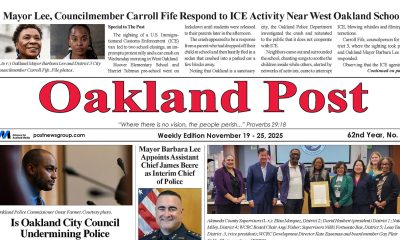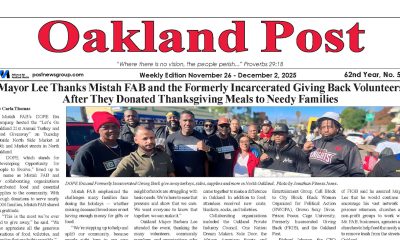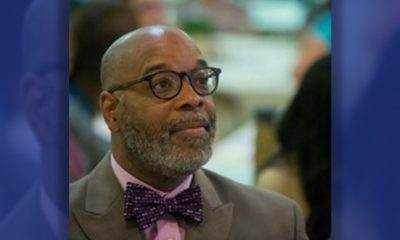Arts and Culture
Opinion: Remembering the Message of Christmas


Rev. Jesse Jackson Sr.
On Wednesday, Christmas will be celebrated by millions of people across this country and across the world. Joy surrounds the holiday, with music in the air, lights on homes and lampposts, families gathering, presents exchanged and blessings shared.
For some, Christmas is a difficult time — for the poor, for separated families, for the lonely, for the imprisoned and the sick. Each year at this time, I use this column to recall the true meaning of Christmas.
Christmas is literally the mass for Christ, marking the birth of Jesus. He was born under occupation. Joseph and Mary were ordered to go far from home to register with authorities. The innkeeper told Joseph there was no room at the inn. Jesus was born on a cold night in a stable, lying in a manger, an “at-risk baby.” His earthly father was a carpenter. Santa Claus wasn’t around — he is an invention of 19th century Europe.
Jesus was born at a time of great misery and turmoil, with his country under Roman occupation. Prophets predicted that a new Messiah was coming, a King of Kings, one who would rout the occupiers and free the people. Many expected a mighty warrior— like the superheroes of today’s movies — who would mobilize an army to defeat Rome’s occupying legions.
Fearing the prophecy, the Roman King Herod ordered the “massacre of the innocents,” the slaughter of all boys two and under in Bethlehem and the nearby region.
Jesus confounded both Herod’s fears and the peoples’ hopes. He was a man of peace, not of war. He gathered disciples, not soldiers. He began his ministry by quoting Isaiah 62:1: “The Lord has anointed me to bring good news to the poor.” We will be judged, he taught us, by how we treat “the least of these,” by how we treat the stranger on the Jericho Road. He called on us to feed the hungry, to clothe the naked, to care for the sick, to offer aid to the refugee.
It’s an extraordinary story. Jesus was a liberator, but by his words and his example, not his sword. He converted rather than conquered. He accumulated no worldly wealth. He threw the money lenders from the temple. During his ministry, he owned no home, no land, and had no regular paycheck. His time with us was too brief, and he was crucified for his ministry.
And yet, he succeeded beyond all expectation to transform the world. The Prince of Peace, he taught us that peace is not the absence of violence; it is the presence of justice and righteousness.
These days, the mass for Christ too often is viewed as a holiday and a payday for Santa, rather than a holy day, more secular than sacred. It is a time of sales, shopping and Santa, when its focus should be on the poorest among us. It is a time to stop a moment and take stock of where we are in light of the mission to bring “good news to the poor.”
There is good news: unemployment is down, poverty is down, incomes have slowly begun to rise. We continue to lock up more people than any nation in the world, but at both the state and federal level, small steps are being taken to reduce the number of nonviolent offenders who are incarcerated.
But surely, we have a long way to go. We are ignoring a climate crisis that threatens all of God’s creation. The U.S. continues to waste lives and literally trillions in wars without end and without apparent purpose. Inequality is at record extremes, and the tax cut Congress passed is making it worse.
Millions still struggle in this rich country to secure adequate food to eat, yet the administration is cutting support for food stamps that allow the working poor to feed their families. On our borders, the administration descended to tearing babies away from their mothers and keeping so many locked up that we have no facilities to house them. Health care, a basic human right, remains unaffordable for too many. Homelessness is rising, as adequate housing is priced out of the reach of more and more in our major cities.
Jesus was not a partisan, but his birth was immensely political — both in the expectations of the people and the fears of the occupiers. Instead of turning us on one another, he called us to our highest selves. We should not let the deeper meaning of Christmas be lost in the wrappings.
In Chicago on Christmas Day, I will go with my family — as we do every year — to visit the prisoners at the Cook County Jail, one of the largest jails in this country. That reflects the real meaning of the Christmas story.
In this secular age, let us remember the message of Christmas. Jesus demonstrated the astonishing power of faith, hope and charity, the importance of love. He showed that people of conscience can make a difference, even against the most powerful oppressor.
He demonstrated the strength of summoning our better angels, rather than rousing our fears or feeding our divisions. This Christmas, this surely is a message to remember.
Merry Christmas, everybody.
Alameda County
Bling It On: Holiday Lights Brighten Dark Nights All Around the Bay
On the block where I grew up in the 1960s, it was an unwritten agreement among the owners of those row homes to put up holiday lights: around the front window and door, along the porch banister, etc. Some put the Christmas tree in the window, and you could see it through the open slats of the blinds.

By Wanda Ravernell
I have always liked Christmas lights.
From my desk at my front window, I feel a quiet joy when the lights on the house across the street come on just as night falls.
On the block where I grew up in the 1960s, it was an unwritten agreement among the owners of those row homes to put up holiday lights: around the front window and door, along the porch banister, etc. Some put the Christmas tree in the window, and you could see it through the open slats of the blinds.
My father, the renegade of the block, made no effort with lights, so my mother hung a wreath with two bells in the window. Just enough to let you know someone was at home.
Two doors down was a different story. Mr. King, the overachiever of the block, went all out for Christmas: The tree in the window, the lights along the roof and a Santa on his sleigh on the porch roof.
There are a few ‘Mr. Kings’ in my neighborhood.
In particular is the gentleman down the street. For Halloween, they erected a 10-foot skeleton in the yard, placed ‘shrunken heads’ on fence poles, pumpkins on steps and swooping bat wings from the porch roof. They have not held back for Christmas.
The skeleton stayed up this year, this time swathed in lights, as is every other inch of the house front. It is a light show that rivals the one in the old Wanamaker’s department store in Philadelphia.
I would hate to see their light bill…
As the shortest day of the year approaches, make Mr. King’s spirit happy and get out and see the lights in your own neighborhood, shopping plazas and merchant areas.
Here are some places recommended by 510 Families and Johnny FunCheap.
Oakland
Oakland’s Temple Hill Holiday Lights and Gardens is the place to go for a drive-by or a leisurely stroll for a religious holiday experience. Wear a jacket, because it’s chilly outside the Church of Jesus Christ of Latter-day Saints, at 4220 Lincoln Ave., particularly after dark. The gardens are open all day from 9 a.m. to 9 p.m. with the lights on from dusk until closing.
Alameda
Just across the High Street Bridge from Oakland, you’ll find Christmas Tree Lane in Alameda.
On Thompson Avenue between High Street and Fernside drive, displays range from classic trees and blow-ups to a comedic response to the film “The Nightmare Before Christmas.” Lights turn on at dusk and can be seen through the first week in January.
Berkeley
The Fourth Street business district from University Avenue to Virginia Street in Berkeley comes alive with lights beginning at 5 p.m. through Jan. 1, 2026.
There’s also a display at one house at 928 Arlington St., and, for children, the Tilden Park Carousel Winter Wonderland runs through Jan. 4, 2026. Closed Christmas Day. For more information and tickets, call (510) 559-1004.
Richmond
The Sundar Shadi Holiday Display, featuring a recreation of the town of Bethlehem with life-size figures, is open through Dec. 26 at 7501 Moeser Lane in El Cerrito.
Marin County
In Marin, the go-to spot for ‘oohs and ahhs’ is the Holiday Light Spectacular from 4-9 p.m. through Jan. 4, 2026, at Marin Center Fairgrounds at 10 Ave of the Flags in San Rafael through Jan. 4. Displays dazzle, with lighted walkways and activities almost daily. For more info, go to: www.marincounty.gov/departments/cultural-services/department-sponsored-events/holiday-light-spectacular
The arches at Marin County Civic Center at 3501 Civic Center Dr. will also be illuminated nightly.
San Francisco
Look for light installations in Golden Gate Park, chocolate and cheer at Ghirardelli Square, and downtown, the ice rink in Union Square and the holiday tree in Civic Center Plaza are enchanting spots day and night. For neighborhoods, you can’t beat the streets in Noe Valley, Pacific Heights, and Bernal Heights. For glee and over-the-top glitz there’s the Castro, particularly at 68 Castro Street.
Livermore
The winner of the 2024 Great Light Flight award, Deacon Dave has set up his display with a group of creative volunteers at 352 Hillcrest Avenue since 1982. See it through Jan. 1, 2026. For more info, go to https://www.casadelpomba.com
Fremont
Crippsmas Place is a community of over 90 decorated homes with candy canes passed out nightly through Dec. 31. A tradition since 1967, the event features visits by Mr. and Mrs. Claus on Dec. 18 and Dec. 23 and entertainment by the Tri-M Honor Society at 6 p.m. on Dec. 22. Chrippsmas Place is located on: Cripps Place, Asquith Place, Nicolet Court, Wellington Place, Perkins Street, and the stretch of Nicolet Avenue between Gibraltar Drive and Perkins Street.
Advice
COMMENTARY: If You Don’t Want Your ‘Black Card’ Revoked, Watch What You Bring to Holiday Dinners
From Thanksgiving to Christmas to New Year’s Day, whether it’s the dining room table or the bid whist (Spades? Uno, anyone?) table, your card may be in danger.

By Wanda Ravernell
Post Staff
From the fourth week of November to the first week in January, if you are of African descent, but particularly African American, certain violations of cultural etiquette will get your ‘Black card’ revoked.
From Thanksgiving to Christmas to New Year’s Day, whether it’s the dining room table or the bid whist (Spades? Uno, anyone?) table, your card may be in danger.
It could take until Super Bowl Sunday for reinstatement.
I don’t know much about the card table, but for years I was on probation by the ‘Aunties,’ the givers and takers of Black cards.
How I Got into Trouble
It was 1970-something and I was influenced by the health food movement that emerged from the hippie era. A vegetarian (which was then considered sacrilegious by most Black people I knew) prepared me a simple meal: grated cheese over steamed broccoli, lentils, and brown rice.
I introduced the broccoli dish at the Friday night supper with my aunt and grandfather. She pronounced the bright green broccoli undone, but she ate it. (I did not, of course, try brown rice on them.)
I knew that I would be allowed back in the kitchen when she attempted the dish, but the broccoli had been cooked to death. (Y’all remember when ALL vegetables, not just greens, were cooked to mush?)
My Black card, which had been revoked was then reattained because they ate what I prepared and imitated it.
Over the decades, various transgressions have become normalized. I remember when having a smoked turkey neck instead of a ham hock in collard greens was greeted with mumblings and murmurings at both the dining room and card tables. Then came vegan versions with just olive oil (What? No Crisco? No bacon, at least?) and garlic. And now my husband stir fries his collards in a wok.
But No Matter How Things Have Changed…
At holiday meals, there are assigned tasks. Uncle Jack chopped raw onions when needed. Uncle Buddy made the fruit salad for Easter. My mother brought the greens in winter, macaroni salad in summer. Aunt Deanie did the macaroni and cheese, and the great aunts, my deceased grandmother’s sisters, oversaw the preparation of the roast beef, turkey, and ham. My father, if he were present, did the carving.
These designations/assignments were binding agreements that could stand up in a court of law. Do not violate the law of assignments by bringing some other version of a tried-and-true dish, even if you call it a new ‘cheese and noodle item’ to ‘try out.’ The auntie lawgivers know what you are trying to do. It’s called a menu coup d’état, and they are not having it.
The time for experiments is in your own home: your spouse and kids are the Guinea pigs.
My mother’s variation of a classic that I detested from that Sunday to the present was adding crushed pineapple to mashed sweet potatoes. A relative stops by, tries it, and then it can be introduced as an add-on to the standard holiday menu.
My Aunt Vivian’s concoctions from Good Housekeeping or Ladies’ Home Journal magazine also made it to the Black people’s tables all over the country in the form of a green bean casserole.
What Not to Do and How Did It Cross Your Mind?
People are, of all things holy, preparing mac ‘n’ cheese with so much sugar it tastes like custard with noodles in it.
Also showing up in the wrong places: raisins. Raisins have been reported in the stuffing (makes no sense unless it’s in a ‘sweet meats’ dish), in a pan of corn bread, and – heresy in the Black kitchen – the MAC ‘n’ CHEESE.
These are not mere allegations: There is photographic evidence of these Black card violations, but I don’t want to defame witnesses who remained present at the scene of the crimes.
The cook – bless his/her heart – was probably well-meaning, if ignorant. Maybe they got the idea from a social media influencer, much like Aunt Viv got recipes from magazines.
Thankfully, a long-winded blessing of the food at the table can give the wary attendee time to locate the oddity’s place on the table and plan accordingly.
But who knows? Innovation always prevails, for, as the old folks say, ‘waste makes want.’ What if the leftovers were cut up, dipped in breadcrumbs and deep fried? The next day, that dish might make it to the TV tray by the card table.
An older cousin – on her way to being an Auntie – in her bonnet, leggings, T-shirt, and bunny slippers and too tired to object, might try it and like it….
And if she ‘rubs your head’ after eating it, the new dish might be a winner and (Whew!) everybody, thanks God, keeps their Black cards.
Until the next time.
Arts and Culture
Fayeth Gardens Holds 3rd Annual Kwanzaa Celebration at Hayward City Hall on Dec. 28
Kwanzaa celebrates seven principles – Nguzu Saba – that support an ideal of community, beginning from Dec. 26 to Jan. 1. Those principles, in Swahili, are: Umoja (Unity), Kujichagulia (Self-Determination), Ujima (Collective Work & Responsibility), Ujamaa (Collective Economics), Nia (Purpose), Kuumba (Creativity) and Imani (Faith).

Entertainment, vendors, and special honors for Sankofa Lifetime Achievement awardees
Special to The Post
Celebrating Ujima, the principle of ‘Collective Work and Responsibility,’ Fayeth Gardens’ 3rd Annual Kwanzaa Celebration will be held on Dec. 28, from 12 noon to 5 p.m.
Kwanzaa celebrates seven principles – Nguzu Saba – that support an ideal of community, beginning from Dec. 26 to Jan. 1.
Those principles, in Swahili, are: Umoja (Unity), Kujichagulia (Self-Determination), Ujima (Collective Work & Responsibility), Ujamaa (Collective Economics), Nia (Purpose), Kuumba (Creativity) and Imani (Faith).
The free event at Hayward City Hall at 777 B St. will feature live entertainment, a guest speaker, awards for community activists whose work reflects the principle of Ujima, vendors and an honoring of the ancestors by Awon Ohun Omnira (Voices of Freedom).
On stage will be the Touch of Class Band, a New Orleans Second-Line Band, and the California Griot Storytellers. Bring the children to have fun in the Kids Korner.
Velda Goe, who has been celebrating Kwanzaa since it started in the 1960s, noticed there was no public celebration of the holiday in Hayward when she moved to the city in 2008.
“I started it a couple of years ago,” she said, “and hopefully it will continue just like the cultural events by other nationalities (in Hayward). The Afro-descendent people of Hayward deserve cultural recognition as well.”
Goe also believes it’s important that Kwanzaa gets its due because “there are so many misconceptions,” particularly by people of other nationalities, who are under the impression “that Kwanzaa is a cult, a religion, or replaces Christmas.”
The celebration, which is open to all, can have the effect of helping guests see that Kwanzaa’a principles and purpose are common to all
This year’s Sankofa Lifetime Awardees are:
- Mrs. Freddye M. Davis: President of the South Hayward NAACP
•Baba Arnold X.C. Perkins: Co-founder of the Brotherhood of Elders
•Frederick Jordan,: Legendary founder of F.E. Jordan & Associates and the Design Engineer for the Charles P. Howard Container Terminal at the Port of Oakland + 1,000 Projects
Come dressed up in your best African wear to enter a raffle for a prize for best-dressed Afrocentric King and Queen.A free, healthy soul food lunch is available with an Eventbrite ticket, which can be found at for free lunch is available from for 11:30 to 12 p.m.
In its third year, the event is the brainchild of Velda Goe, founder of Fayeth Gardens, a community planting site to educate and provide a means for urban dwellers to grow healthy food for their families and develop life-sustaining eating habits.
Interested in being a vendor, volunteer, or sponsor? Reach out to FayethGardens@gmail.com
For tickets, go to: https://www.eventbrite.com/e/fayeth-gardens-3rd-annual-kwanzaa-celebration-at-hayward-city-hall-tickets-1974966953322
-

 Activism4 weeks ago
Activism4 weeks agoOakland Post: Week of November 19 – 25, 2025
-

 #NNPA BlackPress3 weeks ago
#NNPA BlackPress3 weeks agoLIHEAP Funds Released After Weeks of Delay as States and the District Rush to Protect Households from the Cold
-

 Alameda County3 weeks ago
Alameda County3 weeks agoSeth Curry Makes Impressive Debut with the Golden State Warriors
-

 Activism3 weeks ago
Activism3 weeks agoOakland Post: Week of November 26 – December 2, 2025
-

 #NNPA BlackPress3 weeks ago
#NNPA BlackPress3 weeks agoSeven Steps to Help Your Child Build Meaningful Connections
-

 #NNPA BlackPress4 weeks ago
#NNPA BlackPress4 weeks agoBeyoncé and Jay-Z make rare public appearance with Lewis Hamilton at Las Vegas Grand Prix
-

 #NNPA BlackPress3 weeks ago
#NNPA BlackPress3 weeks agoSeven Steps to Help Your Child Build Meaningful Connections
-

 #NNPA BlackPress4 weeks ago
#NNPA BlackPress4 weeks agoLewis Hamilton set to start LAST in Saturday Night’s Las Vegas Grand Prix






















































